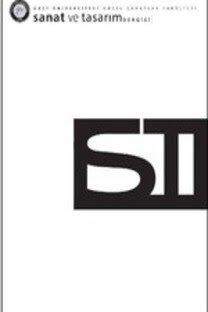Bilgisayar Destekli Seramik Üretim Yöntemi Olarak Üç Boyutlu Yazıcılar ve Günümüz Koşullarında Uygulama Örneği
Bilgisayar destekli üretim yöntemlerinden olan üç boyutlu yazıcılar, günümüzde yaygın olarak kullanılmaktadır. Hızlı prototipleme teknolojisinden hareketle temelleri atılan ve 1980’lerde geliştirilerek patenti alınan bu yöntemden günümüzde otomotiv, mimari, inşaat, tıp, endüstriyel tasarım, moda tasarımı, gıda gibi birçok farklı alanda faydalanılmaktadır. Üretilecek olan ürünün malzemesi ve özelliklerine bağlı olarak farklılık gösteren üç boyutlu yazıcıların türleri ve farklı çalışma prensipleri bulunmaktadır. Bu yazıcılarda plastik, metal, polimer ve seramik gibi farklı malzemeler işlenebilmektedir.Üç boyutlu yazıcılar ile seramik üretimi, yöntem olarak harç yığma, toz bağlama ve seçici lazer sinterleme prensiplerine göre çalışmaktadır. Günümüzde hala gelişmekte olan bu teknoloji dünyada çeşitli sanatçılar ve atölyeler tarafından kullanılmaktadır. Bu dijital üretim şekli, seramik sanatında yeni bir buluş, elle şekil verilmesi zor olan formların üretiminde oldukça ilgi çeken yeni bir şekillendirme yöntemi olarak kabul edilmektedir. Bu araştırma seramik alanında üç boyutlu yazıcıların kullanımı ve işlevselliğine dair genel bilgiler verirken, bir üretim yöntemi olarak üç boyutlu seramik yazıcıların günümüz koşullarında değerlendirilmesi ve geliştirilmesi adına örnek oluşturmaktadır. Bu çalışmada harç yığma prensibine göre seramik malzeme ile çalışan üç boyutlu yazıcı ile üretim, bu üretim esnasında karşılaşılan problemler, bu problemlerin çözümü noktasında neler yapılabileceği, uygulama örnekleri ile ele alınmıştır.
Anahtar Kelimeler:
Seramik, Üç Boyutlu Yazıcı, Bilgisayar Destekli Tasarım, Eklemeli Üretim
Three Dimensional Printers as a Way of Computer Aided Ceramics Manufacturing and a Case Study in Today's Conditions
Three dimensional printers as a way of computer aided manufacturing have been used commonly today. Tis method, which was grounded on rapid prototyping technology and developed in 1980s and patented, is used many different fields today such as automotive, architecture, construction, medicine, industrial design, fashion design and food industry. Depending on the material and properties of the product to be manufactured, there are different types and operating principles of three dimensional printers. Different kinds of materials such as plastics, metal, polymer and ceramics are processed in these printers. Ceramics manufacturing with three dimensional printers operates according to the principles of mortar masonry, encrusting and laser sintering. Tis technology which has been still developing has been used by different artists and workshops. This way of digital manufacturing is accepted as a new invention in the art of ceramics and a quite attractive way of shaping of forms which are hard to mold in hand. In this research, general information about the usage and the functionality of three dimensional printers in ceramics field will be given, and it will be an example to develop and use three dimensional printers in today’s conditions. The manufacture with three dimensional printers that operate according to the principle of stratigraphic manufacturing; the problems during this manufacturing process, what should be done to solve these problems and application examples are going to be analyzed in this research.
___
- ÇELİK, İ., KARAKOÇ, F (2013) “Hızlı Prototipleme Teknolojileri ve Uygulama Alanları“. Dumlupınar üniversitesi Fen Bilimleri Enstitüsü Dergisi, Sayı :31 s: 53-70
- DELİKANLI,K. SOFU, M (2005) “Üretim Sektöründe Hızlı Direkt İmalat Sistemlerinin Yeri Ve Önemi“. Makine Teknolojileri Elektronik Dergisi, Sayı :4 s:33-39
- HOSKINS, S, (2011) “Solid free-form fabrication in fired ceramic as a design aid for concept modelling in the ceramic industry “
- HUll, C. W. (2015). “The Birth of 3D Printing. Research-Technology Management“, 58(6), s: 25-30.
- HUSON, D. (2009) “Materials and Process Innovation for 3D Printing of Ceramics” Symposium, “3 Print Technologies and their creative application within the arts and crafts” Bristol
- HUSON,D. HOSKINS, S.(2014) “3D Printed Ceramics for Tableware, Artists/Designers and Specialist Applications“, Key Engineering Materials Vol. 608 (2014) s: 351-357, Switzerland
- (http://www.uwe.ac.uk/sca/research/cfpr/research/3D/research_projects/Denby%20Project%20Report%20Final%2028%20March.pdf) Erişim Tarihi : (28.11.2015)
- KEEP,Jonathan “Make Your Own 3D Delta Printer For Ceramic”. http://www.keep-art.co.uk/Self_build.html (Erişim Tarihi:20.11.2015)
- ÖZGÜNDOĞDU, A. F. (2014). “Seramik Üretiminde Çağdaş Bir Biçimlendirme Yöntemi Olarak Üç Boyutlu Yazıcılar”. 8. Uluslararası Eskişehir Pişmiş Toprak Sempozyumu Bildiriler Kitabı s: 203.
- VERBRUGGEN, D.(2014) “The Road to Better Paste Extrusion”. RepRap Magazine, Sayı:3, s.26-29.
- VERBRUGGEN, D “Philosophy of Unfold“, http://unfold.be/pages/about (Erişim Tarihi: 15.11.2015)
- WALTERS, P. (2012) “Ceramic 3D Printing: A Design Case Study“, Symposium, “Towards a New Ceramic Future” London
- WARNIER C. ve VERBRUGGEN D., (2014) “Printing Things, Visions and Essentials for 3D Printing“, Gestalten/Germany,
- http://keep-art.co.uk/digitial_icebergs.html (Erişim Tarihi : 28.11.2015)
- http://www.dezeen.com/2012/10/17/stratigraphic-manufactury-3d-printing-by-unfold/) (Erişim Tarihi : 25.11.2015)
- http://wohlersassociates.com/history2014.pdf (Erişim Tarihi : 30.11.2015)
- http://www.uwe.ac.uk/sca/research/cfpr/research/3D/index.html (Erişim Tarihi : 25.11.2015)
- http://birimler.dpu.edu.tr/app/views/panel/ckfinder/userfiles/16/files/Dergiler/31/6.pdf
- (Erişim Tarihi : 30.11.2015)
- http://diy3dprinting.blogspot.com.tr/p/3d-printing-documents.html (Erişim Tarihi : 21.11.2015)
- http://teknolojikarastirmalar.com/pdf/tr/01_020405_4_Delikanli_tr.pdf (Erişim Tarihi : 25.11.2015)
- http://www.uwe.ac.uk/sca/research/cfpr/research/3D/research_projects/2009_symposium.html (Erişim Tarihi : 30.11.2015)
- http://www.uwe.ac.uk/sca/research/cfpr/research/3D/research_projects/denby2.pdf
- (Erişim Tarihi: 21.11.2015)
- ISSN: 1308-2264
- Yayın Aralığı: Yılda 2 Sayı
- Başlangıç: 2015
- Yayıncı: Ankara Hacı Bayram Veli Üniversitesi
